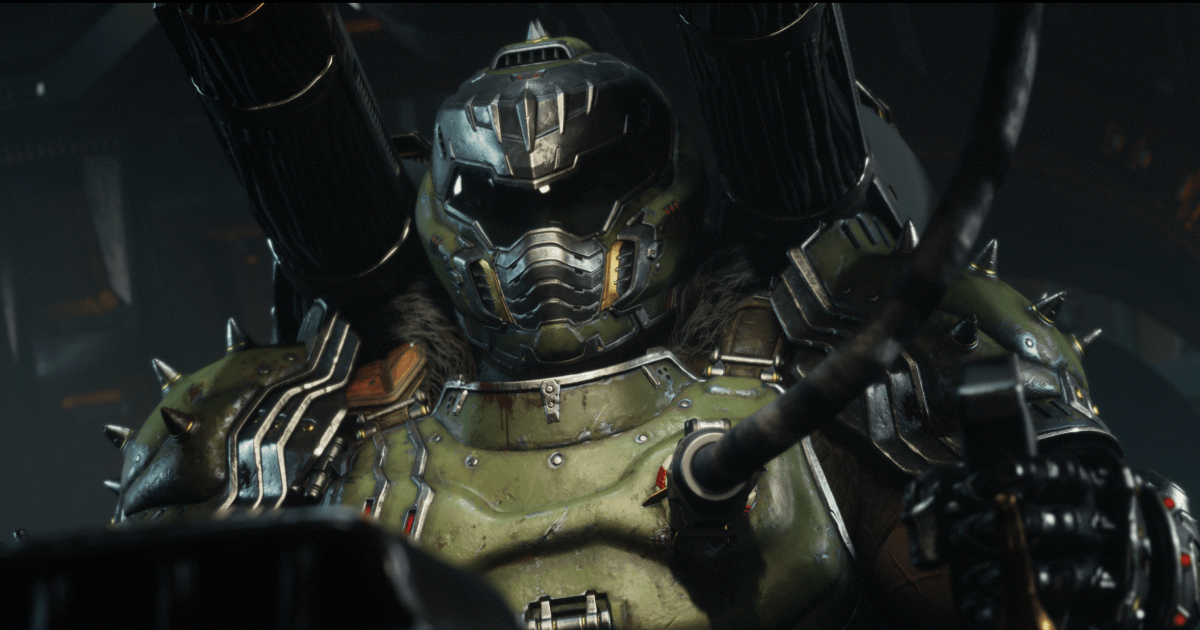Game directors Marty Stratton and Hugo Martin are sitting across from me in Hell. Well, it’s technically a room decorated in the style of Doom: The Dark Ages, Id Software’s highly anticipated first-person shooter launching on May 15, but it might as well be Hell. An eerie red glow is cast over the space, plumes of smoke spew from what looks like chasms leading to dark, demon-filled depths, and a medieval version of the iconic Doomslayer helmet rests on a nearby column.
But the most interesting bit of decor in this demonic space is a massive, jagged-edged shield, which sits between the three of us as we chat after my lengthy hands-on session with Doom: The Dark Ages. That shield represents id’s desire to shake up the Doom franchise — not just in its gameplay, which is very different from the last two Doom titles, but in its storytelling as well.
Doom diehards, don’t fret. The Dark Ages still looks, feels, and headbangs like a Doom game.
I am your shield
Doom: The Dark Ages is similar to the last two titles id Software has released: the 2016 reboot and 2020’s Doom: Eternal, but with fun tweaks and additions that offer you a brand new arsenal of weapons and upgrades for you to wield at your leisure. The Saw is its crown jewel.
Known as the Shield Saw, it’s a weapon that both protects and attacks and fundamentally changes the Doom gameplay loop. After several hours with the game, the shield became my new favorite toy, like a deadly teddy bear keeping me safe from all the scary monsters. I was curious about the team’s thought process in adding such a dramatically different Doom weapon into the fray.
“That was the goal,” Martin tells Digital Trends. “To innovate as much as we could. There’s a needle and thread, though. You still want it to feel like a Doom game.”
And it does. The shield won’t protect you forever — it has a blocking meter that runs out and requires you to attack to recharge it, so Doom’s legacy of pushing players towards a massive firefight remains intact. You can also use the Shield Saw to deflect and parry Hell Surge projectiles, hurl it at hard-to-reach places to open up doors or complete puzzles, and, most importantly, throw it at super-heated armor (indicated by an orange glow) and crack it off of big bad guys with a satisfying crash of metal.
In short, it’s f*****g fun.
It’s kind of like web slinging …
Martin says the team looked back at the original Doom and its grounded, three-dimensional shoot-em-up style for inspiration, which they then melded with medieval and Ancient Greek vibes of The Dark Ages. “300 when Leonidas breaks the phalanx and he’s got the shield and the Spartan sword and the spear, we very much wanted the player to feel like that.” Martin says.
The first section of my hands-on is a traditional Doom experience: a linear, explorable space filled with demons, featuring some tucked-away areas that hide collectibles or Life Sigils (which afford you an extra life upon death) accessible only after finding a key card or completing a puzzle. Early on, an orbital supply drop smashes into the ground in front of me, producing from it a mean-looking melee gauntlet. Smacking the hell out of an enemy with the gauntlet (which has three charges before requiring a timed cooldown) will make them drop ammo, so you’re encouraged to use it to dive into hordes of baddies and start swinging.
“You solve problems with your shield, you gain things with your fists, and you hurt things with your guns,” Martin says simply.
Playing modern Doom games feels like driving a monster truck that spews fire from its exhaust pipes and Pentagram from its speakers while you’re hopped up on Red Bull and Zyns. The Dark Ages delivers more of that. The loop between the shield, the gauntlet, and whatever ridiculous gun I had in my hand at any given moment was like conducting a symphony of death that guided me through every battle.
“It’s kind of like web slinging,” Martin says of the type of gameplay the addition of the shield encourages. “You can just pinball yourself around the arena … you can move around the space more aggressively.”
The added layer of the shield is a boon for a player like me, who often prefers to survey the battlefield rather than run right in. The shield allows me to protect myself while being more aggressive, which led to me parkouring around arenas and laying waste to dozens of uglies.
“I saw you were parrying quite a bit,” Martin points out.
In the last section of my hands-on, I was given access to a much more open, explorable area filled with enemy encounters, portals, puzzles, and most importantly, Sentinel Shrines, which let you upgrade your build. As a now-outed Shield Saw girl, I decided to upgrade it so that every time I hit an enemy with a shield or successfully parried a Hell Surge attack, I’d get ammo for my preferred weapon, the Impaler.
Later, I upgraded it so that I could ping the Shield Saw between enemies like a serrated pinball. There are dozens of upgrade options centered around the shield, the gauntlet, and the Doomslayer’s arsenal of weapons, offering players a chance to customize their build to bring death in whichever way they’d like.
There’s also a host of accessibility options, like a camera shake slider, a world desaturation slider, and the ability to turn off environmental screen shake. Difficulty modifiers let players further tune Doom: The Dark Ages to their playstyle, from the ability to adjust the parrying window, to toggle on/off enhanced targeting and empowered attacks, and even slow enemy projectile speed.
Demons and dragons
If you ever played Doom and thought, “This is fun, but it would be even more fun if I could climb into an Atlan mech and Kaiju battle a demonic Titan and then later jump on a huge dragon and fly into battle,” you’re in luck. Of the four levels played during my hands-on, two were dedicated to newer ways to raise Hell in Doom: in a huge mech suit laying waste to everything in your path and astride a massive, armored-up dragon.
Martin is very excited about the mech, telling me he’s wanted something like it in a Doom game since he was 13 years old. I only played a snippet of the full level, which had me stomping through a city under siege to get to enemy encounters, during which the Atlan can dodge attacks, shoot a massive gun, or punch the monsters repeatedly like a giant game of Rock ‘Em Sock ’Em Robots. It’s simple, satisfying, and gleefully absurd.

The dragon is more elegant in design, letting you ascend and descend rapidly and smoothly with the press of a button as you soar through a massive cavern — though I found its lock-on ability, which lets you pivot around a target while firing an auto-cannon, to be sticky and awkward. But flying on the back of a huge dragon donning medieval armor is as fun and joyful as it sounds, an almost welcome respite from ripping and tearing.
And that’s intentional. The Atlan and dragon levels, of which Stratton tells me there are several, are designed to be “nice, refreshing pace breakers” that he feels are “really cool beats” throughout the game. It feels like The Dark Ages aims to elevate Doom even further, to improve upon an already winning formula.
“You have a certain amount of resources and time and money that you can put toward something, so some early decisions allowed Hugo [Martin] to fulfill his 13-year-old dream and bring a mech into Doom,” Stratton says as Martin laughs beside him. “I think it’s the right decision. These are really cool beats throughout the game.”

New gameplay elements, when coupled with fully animated cutscenes, makes The Dark Ages feel like Id Software had a little extra gas when cooking, an added layer of AAA sparkle that glistens like a blood-soaked sword hilt.
“It makes it more complete as an experience,” Stratton says. And the team was able to add these new, long-sought-after elements solely because of an early decision made in-house: The Dark Ages will be single-player only.
“2016 and Eternal both had a multiplayer component,” Stratton explains. “The decision to go campaign early really gave us the resources and the capability to put in some of the things like the Atlan and the dragon, to do the story the way we’re doing it.”
We were sitting around watching all the best ‘80s and ‘90s action movies, really studying the genre.
The Dark Ages will tell its story through cutscenes rather than codex entries, as the series has traditionally done, and from the few that I’ve seen, expect some freaky-looking guys, some scary ladies, and some serious guitar riffs (all of which, like the gameplay, look and sound amazing). Martin leveraged his connections to his from Blur Studios, a visual arts and animation studio, to get some great people working on cutscenes.
“We had a ball doing it. We were sitting around watching all the best ‘80s and ‘90s action movies, really studying the genre,” Martin says. “What makes it work? We all know Roadhouse is a good movie, but let’s go beyond that — why sit a good movie? Rambo, Predator, Die Hard, what makes these things really work and what can we take from that and apply it to our game?”
The results are as face-melting as you’d hope. Watching a Dark Ages cutscene feels like when Mad Max: Fury Road’s War Boys huff chrome paint before going into battle — you can’t see one and not want to rip the heart out of a demon immediately afterward. Lucky for you, Doom: The Dark Ages will let you rip out hearts and tear through armor as much as you’d like, and it’ll pump you up to previously unimaginable heights before letting you loose.
Doom: The Dark Ages releases for Xbox Series X/S, PS5, and PC on May 15.
Read the full article here















